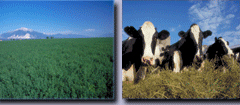 Have you tried an American Legends pizza yet from Domino’s? The pizza, which uses 40% more cheese, is one reason why Domino’s was able to report a profit for 2009, and is good news for dairy farmers.
Have you tried an American Legends pizza yet from Domino’s? The pizza, which uses 40% more cheese, is one reason why Domino’s was able to report a profit for 2009, and is good news for dairy farmers.
The improving sales prospects for Domino’s Pizza, Inc., could help deliver a boost for slumping cheese prices. Domino’s, which owns or franchises more than 4,900 U.S. locations, projects domestic same-store sales to increase 1 percent to 3 percent this year from last year, the company said in its fourth-quarter earnings statement today. International same-store sales are expected to rise 3 percent to 5 percent, Domino’s said.
The company’s efforts to retool and promote its pizzas are paying off, resulting in traffic growth in all four quarters of 2009, Domino’s Chief Executive Office David Brandon said. Domestic same-store sales rose 0.9 percent for all of 2009, Domino’s said.
Growth was “most significant” during the fourth quarter, Brandon said in today’s statement. “This positive momentum has continued thus far in 2010, as sales and traffic have increased significantly since the launch of our new core pizza.”
Increased pizza consumption may help trim excess cheese supplies and provide a lift for beleaguered dairy producers still reeling from a milk price crash. Pizza generates about $32.5 billion in annual restaurant and grocery store revenue, and about a quarter of all cheese sold is used to make pizza, according to Dairy Management Inc.
The same-store sales outlook is “some much needed good news for the market,” said Scott Brown, a livestock and dairy economist at the Food and Agricultural Policy Research Institute in Columbia, Mo. “We must have some demand growth if we want milk prices to move higher and stay higher in 2010.”
At the end of January, U.S. cheese inventories totaled 980.8 million pounds, up 11 percent from a year earlier, according to U.S. Department of Agriculture data. Cheese prices will likely stay below $1.40 a pound for a few months without some additional cheese sales, Brown said. “We have a ways to go yet but this hopefully is the start of good news on the demand front,” he said.
In November, Brandon, the Domino’s CEO, told Dairy Herd Management that using more cheese was yielding benefits. The company’s “cheese-enhanced” American Legends pizzas accounted for a double-digit share of overall pizza sales, and the share is growing, Brandon said.
“When you talk about a product that achieves double-digit mix in its first year of introduction, that is big,” Brandon told Dairy Herd Management.
Source: Bruce Blythe, Vance Publishing

 The Supreme Court will soon make a decision on whether or not farmers can grow biotech alfalfa – and it could ultimately impact other genetically modified crops.
The Supreme Court will soon make a decision on whether or not farmers can grow biotech alfalfa – and it could ultimately impact other genetically modified crops.





